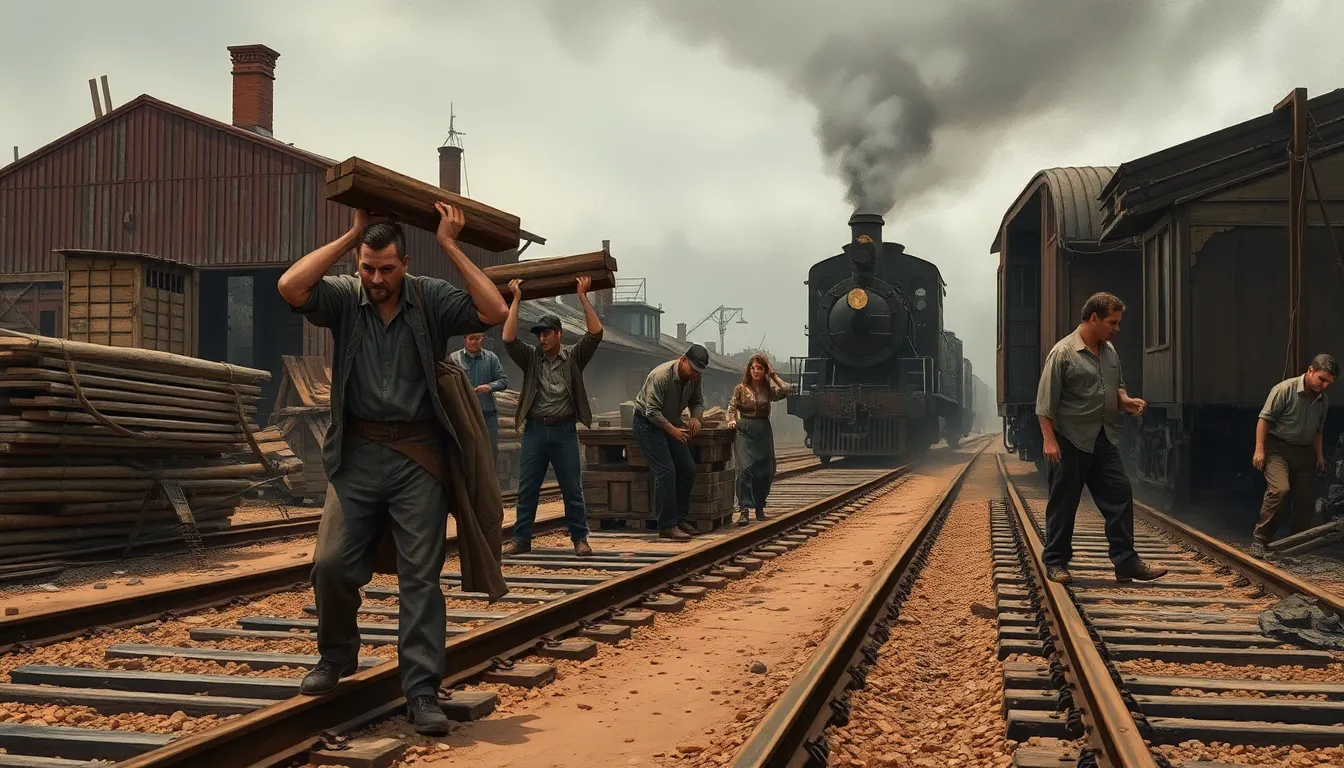Table of Contents
ToggleCornelius Vanderbilt, a titan of the 19th century, built an empire that revolutionized transportation. But amidst the railroads and steamships, one question lingers: how did he treat his workers? Spoiler alert: it wasn’t all steam and sunshine. While Vanderbilt amassed wealth faster than you can say “railroad tycoon,” his labor practices often left much to be desired.
Overview of Vanderbilt’s Business Practices
Cornelius Vanderbilt’s business practices reflected both ambition and disregard for labor rights. He prioritized profits over employee welfare, which often resulted in poor working conditions. Workers faced long hours for minimal pay, alongside a lack of safety measures. Strikes among rail workers highlighted frustrations with low wages and grueling schedules.
Labor unions struggled to gain traction during this period, making it challenging for workers to advocate for their rights effectively. Vanderbilt took a hard stance against unionized labor, often using intimidation and violence to maintain control. He famously hired private security forces to break strikes, further exacerbating tensions.
Compensation varied significantly among workers. Some skilled laborers found better pay due to high demand, while unskilled workers earned considerably less. Vanderbilt’s railroads relied on immigrant labor, which he could pay lower wages due to high competition for jobs.
Moreover, he engaged in ruthless competition with rivals, often prioritizing efficiency over ethical treatment of workers. Reports from the time indicated that accidents were frequent in his shipping and railroad operations, largely due to insufficient safety protocols.
Ultimately, Vanderbilt’s legacy in American industry remains mixed, marked by immense success and a troubling history of labor exploitation. The advancements in transportation did not translate into improved conditions for the workers who powered his empire.
Treatment of Workers in the Railroads

Vanderbilt’s railroads exemplified harsh treatment of workers. Long hours characterized the daily grind, exposing laborers to exhausting schedules without adequate rest. Safety protocols often remained nonexistent, leading to frequent accidents and injuries. Workers bore the burden of demanding physical labor under perilous conditions.
Working Conditions
Working conditions in Vanderbilt’s railroads reflected the era’s disregard for labor. Insufficient ventilation and exposure to hazardous materials plagued many job sites. Injuries frequently occurred due to inadequate safety measures, while access to medical care remained limited for injured employees. Complaints about these dire conditions often fell on deaf ears, further illustrating the lack of concern for worker welfare. Throughout the industry, the reliance on immigrant labor compounded these challenges, as these workers had little leverage to demand improvements.
Wages and Hours
Wages and hours for Vanderbilt’s workers varied noticeably based on skill level. Skilled laborers enjoyed higher pay due to their specialized abilities, whereas unskilled laborers, often immigrants, earned significantly less. Many workers toiled for minimal financial compensation, with some reporting grueling shifts of up to 16 hours a day. Over time, labor strikes emerged, showcasing employee frustration over low wages and exhausting hours. These economic pressures drove many workers to push for better conditions, yet Vanderbilt consistently prioritized profits over fair compensation.
Vanderbilt’s Attitude Toward Labor Unions
Cornelius Vanderbilt exemplified an aggressive stance against labor unions, consistently opposing organized efforts among workers.
Responses to Strikes
Vanderbilt responded to strikes with intimidation tactics. He utilized private security forces to quell unrest, often resorting to violence to suppress dissent. Strikes among rail workers highlighted low wages and harsh working conditions, yet Vanderbilt remained steadfast. Workers faced further repercussions, including job loss and violence, when they attempted to unionize. His ultimate goal focused on maintaining productivity and profit margins, disregarding the social and economic needs of laborers. The heavy-handed response to labor unrest solidified his reputation as an unsympathetic employer.
Impact on Worker Rights
Worker rights suffered significantly under Vanderbilt’s leadership. Laborers lacked basic protections and faced persistent exploitation. Unions struggled to gain ground, as Vanderbilt actively thwarted their efforts. The absence of regulations led to unsafe working environments. Employees endured long hours in hazardous conditions, often without recourse for grievances. Vanderbilt’s influence limited advancements in labor rights during this era. His prioritization of profit over people set a troubling precedent that affected generations of workers in the industry.
Comparison with Other Industrialists
Cornelius Vanderbilt’s labor practices can be contrasted with those of other industrialists like Andrew Carnegie and John D. Rockefeller. Their treatment of workers provides a broader understanding of labor relations in the industrial age.
Treatment of Workers by Carnegie
Andrew Carnegie, known for his steel empire, adopted a different approach. He strongly advocated for self-improvement and education, often promoting the idea of workers being helped by their employer. However, workers faced harsh conditions and long hours in steel mills. The Homestead Strike of 1892 highlighted severe labor disputes, where Carnegie’s management used violence against striking workers. Despite some philanthropic efforts later in life, workers experienced significant suffering under his watch.
Treatment of Workers by Rockefeller
John D. Rockefeller’s business practices also exhibited a complex relationship with labor. He often aimed for efficiency and productivity, leading to exploitation. Workers in his oil refineries encountered grueling hours and minimal safety measures. The Ludlow Massacre of 1914 illustrated the violent response to labor activism. While Rockefeller contributed to philanthropy, these efforts came after years of labor strife. The legacy of both Carnegie and Rockefeller reflects a mix of industrial success and troubling treatment of workers, much like Vanderbilt.
Legacy of Vanderbilt’s Labor Practices
Vanderbilt’s legacy includes significant implications for labor practices. Worker rights faced severe limitations under his management. Exploitation emerged as a common experience among employees, who endured long hours with minimal pay. Poor working conditions persisted across the railroads and steamships he controlled. Without safety measures, laborers risked their health on the job.
Intimidation served as a primary tool for Vanderbilt against unionization. Many workers encountered fierce opposition when attempting to organize. Active resistance to labor movements showcased his commitment to maintaining control. The oppressive atmosphere created a culture of fear for those seeking better conditions. Violent responses to strikes further demonstrated a disregard for workers’ rights.
Comparisons to contemporaries like Carnegie and Rockefeller reveal similar patterns. Carnegie’s steel empire faced criticism for brutal labor disputes. The notorious Homestead Strike of 1892 highlighted harsh realities for workers during his reign. Rockefeller’s pursuit of efficiency resulted in worker exploitation, exemplified by the Ludlow Massacre. All three industrialists shared a troubling legacy, intertwining success with exploitation.
Progress in labor rights stalled during Vanderbilt’s era. His influence set a precedent that affected countless workers in following generations. The structural framework he established prioritized profit over the workforce’s welfare. Consequently, advancements in industry failed to equate with improved conditions for the laborers driving growth. Vanderbilt’s complex legacy underscores the harsh realities of the industrial age, revealing the intersection of wealth and labor struggles.
Vanderbilt’s approach to labor left a lasting impact on the workforce during the industrial age. His prioritization of profits over employee welfare created an environment rife with exploitation and intimidation. Workers faced significant challenges in their pursuit of better conditions and fair treatment.
The legacy of his harsh labor practices highlights the broader struggles faced by workers across industries. While Vanderbilt achieved remarkable success in transportation, the cost to laborers was steep. The pattern of exploitation established during his reign resonates through history, serving as a cautionary tale about the intersection of wealth and worker rights.




